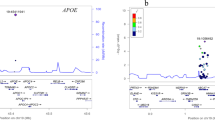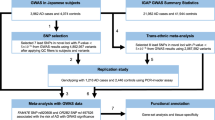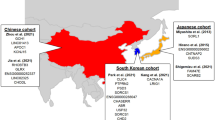Abstract
The ɛ4 allele of the apolipoprotein E gene (APOE) is unequivocally recognized as a genetic risk factor for late-onset Alzheimer's disease (LOAD). Recently, single-nucleotide polymorphisms (SNPs) of the GRB2-associated binding protein 2 gene (GAB2) were shown to be associated with LOAD in Caucasians carrying the APOE-ɛ4 allele through a genome-wide association study. Here, we attempted to replicate the finding by genotyping these SNPs in a large clinical cohort of Japanese. We observed no association of any of the SNPs with LOAD. GAB2 may not be a disease susceptibility gene for LOAD in Japanese.
Similar content being viewed by others
Introduction
It is well known that the development of Alzheimer’s disease (AD) is consequence of complex interactions between multiple genetic and environmental factors. To date, only the ɛ4 allele of the apolipoprotein E gene (APOE) is universally recognized as a genetic risk factor for late-onset AD (LOAD) in a variety of populations,1, 2, 3 but not in elderly Nigerians.4 As the presence of risk genes other than APOE is speculated,5 many studies have been performed to identify them.
Genome-wide association studies (GWAS) involving high-density single-nucleotide polymorphism (SNP) genotyping technologies have led to great success in the identification of risk genes for various common diseases.6, 7 With regard to LOAD, the GRB2-associated binding protein 2 gene (GAB2) on chromosome 11q was recently identified in Caucasians through GWAS: 10 SNPs of this gene have been shown to be associated with LOAD in APOE-ɛ4 carriers.8 It is noteworthy that the most significant SNP, rs2373115, exhibits an odds ratio (OR) of 4.1 (95% confidence intervals (Cis), 2.8–14.7), which is almost equal to the strong risk effect exerted by the APOE-ɛ4 allele (ɛ3 vs ɛ4, OR=3.2–4.1).2 Furthermore, the following findings with relation to AD neuropathology have been made:8 in LOAD brains GAB2 is detected in highly dystrophic neurons, including neurofibrillary tangle (NFT)-bearing neurons, and interference with GAB2 expression increases TAU phosphorylation, which leads to NFT formation. With this genetic and biological evidence, GAB2 is considered to be a promising candidate for LOAD, although a recent replication study revealed a lack of association of this gene with LOAD in Caucasians.9 Therefore, we here assessed whether or not the genetic association of GAB2 with LOAD can be reproduced in Japanese.
Subjects and methods
Subjects
Blood samples were collected by the Japanese Genetic Study Consortium for AD (JGSCAD): the members are listed in our recent publications.10, 11 The LOAD patients were clinically validated, and satisfied the criteria of the National Institute of Neurological and Communicative Disorders and Stroke-Alzheimer's Disease and Related Disorders Association for a diagnosis of probable AD.12 Non-demented controls living in an unassisted manner in the local community were recruited from among elderly subjects. The Mini-mental State Examination (MMSE) and Clinical Dementia Rating and/or the Function Assessment Staging were used to assess severity of the cognitive impairment. Basic information on the sample sets used is presented in Table 1. The total sample size is 1656 LOAD patients (female, 71.6%) and 1656 controls (female, 58.7%), which is large enough to detect risk alleles assuming OR>1.3 (range of risk allele frequency=0.1–0.9, α=0.05, power=80%). This subject group is referred to as overall sample set All in this study (Table 1). A large proportion (79.4%) of the subjects are the same as in our previous overall sample set.10, 11 To construct two sub-sample sets, the All set was stratified as to the APOE-ɛ4 carrier status: Negative-ɛ4 (LOAD, 790; control, 1378) and Positive-ɛ4 (LOAD, 866; control, 278) (Table 1).
This study was approved by the Institutional Review Board of Niigata University, and by all participating institutes. Informed consent was obtained from all controls and appropriate proxies for patients, and all subjects were anonymously subjected to SNP genotyping.
Genotyping
Genomic DNA preparation and genotyping were described previously.10. We did not genotype additional SNPs to the 10 ones reported by Reiman et al,8 as strong LD (∣D′∣>0.8) was observed across the GAB2 (see Supplementary Figure 1).
Statistical analysis
We carried out a Hardy–Weinberg equilibrium (HWE) test based on an exact test, single SNP and haplotype-based case–control studies, haplotype inference, and computation of LD measures (D′). As an estimate of the relative risk of disease, OR with 95% CIs of each marker or haplotype was calculated from a 2 × 2 contingency table. For all statistical analyses mentioned above, we used SNPAlyze® software version 6.0.1 (DYNACOM): the analytical methods were described in detail elsewhere.11 For evaluation of the LD block structure in and around GAB2, Haploview software version 3.32 was used. We considered P<0.05 statistically significant.
Results
To determine whether the GAB2 association can be replicated in Japanese or not, we analyzed the 10 SNPs using a total of 3312 clinical subjects for genotyping (see Supplementary Figure 2). These SNPs are encompassed by GAB2 (Table 2), which consists of 10 exons and spans about 202.4 kb on chromosome 11. To examine population differences in the allele frequencies of the SNPs, we first assessed the HapMap genotype data (http://www.hapmap.org/index.html) for four populations: Japanese in Tokyo (JPT), US Utah residents with northern and western European ancestry (CEU), Han Chinese in Beijing (CHB) and Yoruba in Ibadan, Nigeria. These 10 SNPs for JPT exhibited similar allelic frequencies to CHB, but not to CEU: for example, the frequencies for allele G of SNP rs2373115 were 0.47 for JPT and 0.89 for CEU (see Supplementary Figure 3). HWE exact tests were performed to detect genotyping errors. SNP rs7101429 slightly deviated from the HWE in the All (P=0.0497) and Negative-ɛ4 (P=0.0416) sample sets in LOAD. Remaining nine SNPs were in HWE (P≥0.05) (Table 2).
A single SNP case–control study (χ2 test) was then carried out. We did not observe any significant association of the SNPs with LOAD in not only the All set but also the two subsets (Negative-ɛ4 and Positive-ɛ4) (Table 3). Multiple logistic regression analysis, with adjustment for the carrier status of the APOE-ɛ4 allele, age and gender as covariates, did not reveal any significant evidence of association (data not shown).
Pairwise LD measures, D′, of the SNPs are given in Supplementary Table 1. We found a strong correlation (∣D′∣>0.93) between the 10 SNPs in each of the three sample sets. No difference in the LD block structure was observed between LOAD and control subjects. Using the HapMap genotype data for JPT and CEU, we further performed in silico LD mapping of a genomic region spanning about 500 kb. It was found that GAB2 was completely encompassed by a highly structured single LD block in both JPT and CEU (see Supplementary Figure 1). However, there was an evident difference in the LD block boundary in the 5′ region of GAB2: in JPT, we observed a definitive break point in the block, but not in CEU (see Supplementary Figure 1).
In the LD block, including the whole GAB2, three common haplotypes (frequency >1%), H1, H2 and H3, were inferred in all sample sets (see Supplementary Table 2). Haplotype H2 consisted of all major alleles of the 10 SNPs. In every sample set, no haplotypes exhibited significant differences between LOAD and controls (see Supplementary Table 2).
Discussion
Recently, it was shown that GAB2, encoding a scaffolding adaptor protein involved in several signal-transduction pathways, is associated with LOAD in Caucasians.8 At SNP rs2373115 located within this gene, a noticeable significance in allelic association (Pallele=9.7 × 10−11) has been observed.8 Interestingly, the disease risk of this gene is increased by the APOE-ɛ4 allele: maximum OR of 24.6 (95% CIs, 7.4–116.8) was computed in carriers with both the APOE-ɛ4 and GAB2 SNP rs2373115 risk (G) alleles,8 suggesting a genetic interaction between these two genes. On the basis of these findings, we attempted here to replicate the genetic association of GAB2 with LOAD in Japanese. In Reiman et al's study,8 neuropathologically well-characterized brains of Caucasians were largely used (LOAD, 643; control, 404), whereas we utilized only clinically confirmed subjects (LOAD, 1656; control, 1656). However, no evidence of association of this gene was obtained in the All, Negative-ɛ4 and Positive-ɛ4 sets (Table 3). GAB2 may not be a disease susceptibility gene for LOAD in Japanese.
As a possible explanation for the discrepancy between our results and the initial study,8 we consider an ethnic difference (Japanese vs Caucasian), genotyping technology (TaqMan® vs GeneChip® genotyping) and subject selection (clinically vs neuropathologically verified subjects) described above. With regard to the ethnic difference, Wright's FST statistic has been proposed for clarifying the level of between-population differentiation.13 FST is 0.145 (estimated from 3845 SNPs) among Asian (Japanese and Chinese), African-American and European-American, and 0.013 (estimated from 8801 SNPs) between Japanese and Chinese.14 Across the 10 GAB2 SNPs, we calculated FST using HapMap genotype data of JPT, CHB and CEU. The mean FST of these SNPs was 0.012 (standard deviation (SD), 0.006; range, 0.000–0.025) between JPT and CHB, and 0.219 (SD, 0.077; range, 0.164–0.435) between JPT and CEU. These data indicate that a higher level of genetic differentiation exists between JPT and CEU for GAB2. Recently, Chapuis et al9 could not replicate the initial finding8 even in European-Caucasian subjects (N>3000), suggesting that GAB2 is at best a minor disease susceptibility gene for LOAD. A meta-analysis is needed to confirm the association of GAB2 with LOAD.
References
Farrer LA, Cupples LA, Haines JL et al: Effects of age, sex, and ethnicity on the association between apolipoprotein E genotype and Alzheimer disease. JAMA 1997; 278: 1349–1356.
Bertram L, McQueen MB, Mullin K, Blacker D, Tanzi RE : Systematic meta-analyses of Alzheimer disease genetic association studies: the AlzGene database. Nat Genet 2007; 39: 17–23.
Corder EH, Saunders AM, Strittmatter WJ et al: Gene dose of apolipoprotein E type 4 allele and the risk of Alzheimer’s disease in late onset families. Science 1993; 261: 921–923.
Gureje O, Ogunniyi A, Baiyewu O et al: APOE epsilon4 is not associated with Alzheimer’s disease in elderly Nigerians. Ann Neurol 2006; 59: 182–185.
Daw EW, Payami H, Nemens EJ et al: The number of trait loci in late-onset Alzheimer disease. Am J Hum Genet 2000; 66: 196–204.
Sladek R, Rocheleau G, Rung J et al: A genome-wide association study identifies novel risk loci for type 2 diabetes. Nature 2007; 445: 881–885.
Wellcome Trust Case Control Consortium: Genome-wide association study of 14 000 cases of seven common diseases and 3000 shared controls. Nature 2007; 447: 661–678.
Reiman EM, Webster JA, Myers AJ et al: GAB2 alleles modify Alzheimer’s risk in APOE epsilon4 carriers. Neuron 2007; 54: 713–720.
Chapuis J, Hannequin D, Pasquier F et al: Association study of the GAB2 gene with the risk of developing Alzheimer’s disease. Neurobiol Dis 2008; 30: 103–106.
Kuwano R, Miyashita A, Arai H et al: Dynamin-binding protein gene on chromosome 10q is associated with late-onset Alzheimer’s disease. Hum Mol Genet 2006; 15: 2170–2182.
Miyashita A, Arai H, Asada T et al: Genetic association of CTNNA3 with late-onset Alzheimer's disease in females. Hum Mol Genet 2007; 16: 2854–2869.
McKhann G, Drachman D, Folstein M et al: Clinical diagnosis of Alzheimer’s disease: report of the NINCDS-ADRDA Work Group under the auspices of Department of Health and Human Services Task Force on Alzheimer’s Disease. Neurology 1984; 34: 939–944.
Wright S : Evolution and the Genetics of Populations; the Theory of Gene Frequencies. University of Chicago Press: Chicago, 1969, Vol 2: pp 294–295.
Marchini J, Cardon LR, Phillips MS, Donnelly P : The effects of human population structure on large genetic association studies. Nat Genet 2004; 36: 512–517.
Acknowledgements
We thank the patients with AD and their families, and the control individuals for their participation in this study. We are very grateful to the members of JGSCAD for the collection of blood samples: the members were listed previously.10, 11 We also thank K Horigome, M Hirose, N Yahata, K Takadono, N Takei, T Tsukie, T Gohno and M Asakura for their expert technical support, and NJ Halewood for critical reading of the manuscript. This study was supported by KAKENHI (Grant-in-Aid for Scientific Research) on Priority Areas – Comprehensive Genomics – (RK). There is no conflict of interest to declare.
Author information
Authors and Affiliations
Corresponding author
Additional information
Supplementary Information accompanies the paper on European Journal of Human Genetics website (http://www.nature.com/ejhg)
Supplementary information
Rights and permissions
About this article
Cite this article
Miyashita, A., Arai, H., Asada, T. et al. GAB2 is not associated with late-onset Alzheimer's disease in Japanese. Eur J Hum Genet 17, 682–686 (2009). https://doi.org/10.1038/ejhg.2008.181
Received:
Revised:
Accepted:
Published:
Issue Date:
DOI: https://doi.org/10.1038/ejhg.2008.181
Keywords
This article is cited by
-
Identification of hub genes related to the progression of type 1 diabetes by computational analysis
BMC Endocrine Disorders (2021)
-
Gab2
AfCS-Nature Molecule Pages (2010)
-
The Gab2 in signal transduction and its potential role in the pathogenesis of Alzheimer’s disease
Neuroscience Bulletin (2010)
-
GAB2 is not associated with late-onset Alzheimer’s disease in Chinese Han
Neurological Sciences (2010)
-
Function, regulation and pathological roles of the Gab/DOS docking proteins
Cell Communication and Signaling (2009)



